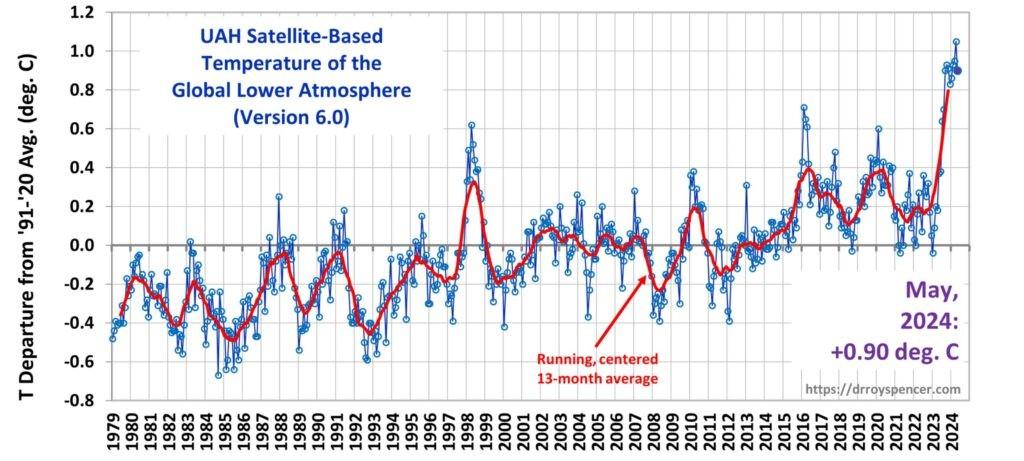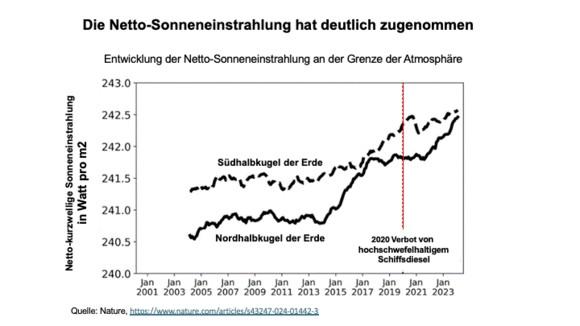Link: https://klimanachrichten.de/2024/06/14/fritz-vahrenholt-warumist-es-waermer-geworden/
Please see link above for source text.
 Fritz Vahrenholt
Fritz Vahrenholt

Link: https://klimanachrichten.de/2024/06/14/fritz-vahrenholt-warumist-es-waermer-geworden/
Please see link above for source text.
 Fritz Vahrenholt
Fritz Vahrenholt
June 14, 2024 by ClimateNews Editor
Monthly newsletter from Fritz Vahrenholt
Dear Ladies and Gentlemen,
To start with, you will receive my usual monitor on global temperature rise. We can see an extraordinary warming in 2023/24. That is why I will look a little more closely at the possible causes of this warming. Because at the moment, this extraordinary increase in temperature is being used as an opportunity to further tighten CO2 policy. That is why I will then look at the burden on citizens caused by the constantly increasing CO2 taxes.

In May 2024, the deviation of the global temperature from the 30-year average of satellite-based measurements from the University of Alabama (UAH) fell compared to April. The value is 0.9 degrees Celsius. The next graph shows that the strong El Nino in the Pacific has ended. The US weather and oceanography agency NOAA even assumes a 70 percent probability that a cold La Nina phase will develop by September.

If you compare the ups and downs of the El Ninos and La Ninas in this graph with the temperature data in the first graph, you can see a good agreement in the particularly warm outlier years 2010/2011, 2015/2016 and 2023/24. There was already a similarly strong El Nino year in 1998/99. But this natural cause of warming is not mentioned in the climate policy debate in Germany. As can be seen in the first diagram of the satellite measurements (see above), the warming trend is 0.15 degrees Celsius per decade, i.e. 0.015 degrees Celsius per year. But even if this warming trend were caused solely by human CO2 emissions, this could never explain a temporary warming of 0.5 to 1 degree from 2023 to 2024.
Nevertheless, the Tagesschau spoke of 2023 as the warmest year since industrialization (to immediately identify the culprit) and thereby underscored the demand for a halt to the Paris Climate Agreement. The MDR spoke of the warmest year in the last 125,000 years . The Federal Environment Agency did mention the El Niño event of 2023 in its statement on the particular warming, but only to take the argument off the table: “ But this El Niño alone cannot explain the extreme record temperatures in 2023.”
New Nature publication explains the warming of the last few years
In addition to the El Niño, there is another effect that has little to do with the increase in CO2. Since 1980, the permeability of clouds to short-wave solar radiation has been increasing. This is leading to an increase in the duration of sunshine worldwide and in Europe. More sunlight in summer means more warming. I had already pointed out this effect in my August 2023 newsletter . Compared to the 1980s, we now have 250 hours more sunshine per year in Europe. One of the possible causes for this, in addition to the ocean cycles, was the decline in aerosols (dust particles in the air) due to the reduction in air pollution worldwide. These dust particles act as condensation nuclei and promote cloud formation.
The reduction in air pollution as the cause of a large part of the warming of recent years has now been confirmed by reality and science.
In 2020, after long disputes, the International Maritime Organization
(IMO) banned the use of high-sulphur fuels by ships. The decline in sulphur-containing emissions on the world's oceans has been enormous since 2020. Shipping emissions were reduced by 77% worldwide in one fell swoop by reducing the maximum sulphur content of marine diesel from 3.5% to 0.5%. NASA scientists concluded in a Nature publication that the IMO air pollution control measure reduced cloud formation and increased short-wave solar radiation. They calculate that 80% of the warming since 2020 can be attributed to this measure.
This means that CO2 can only have caused 20% of the warming since 2020 at the most.
Why is this sensational discovery by NASA researchers not being discussed in the German political climate debate? Only the Potsdam Institute for Climate Impact Research (PIK) sees its own fate slipping away and has, as a precaution, cast doubt on the conclusions of the NASA researchers because - according to Anders Levermann from PIK - the period under review is too short.
The objection is somewhat justified, but the dramatic increase in direct solar radiation has been taking place for years. And dust and sulphur dioxide emissions have been declining worldwide for two decades. This is shown by the NASA graphic published in Nature of the CERES satellites, which measure the radiation incoming to and outgoing from the earth 1024 km above the earth.
The graph shows a sharp increase in solar radiation since the implementation of the IMO's sulphur limit in 2020. But the graph also shows something else. The increase in solar radiation did not begin in 2020. Since 2004, and even more so from 2014 onwards, direct solar radiation has been increasing in both the northern and southern hemispheres: in the north by 1.75 watts/m2, in the south by 1 watt/m2. This effect is caused by the thinning of the clouds, so that more solar radiation can reach the earth's surface.

For comparison: according to the IPCC, the increase in CO2 since 1750 has caused a warming of 2.16 W/m2 ( IPCC, 2023 p. 943 ). This corresponds to the same magnitude as the increase in solar radiation since 2004.
Hans-Rolf Dübal and Fritz Vahrenholt had already published a similar result to the NASA researchers in 2021 in the scientific journal “atmosphere” , in which only 20% of the warming of the last 20 years can be attributed to CO2.
The result of the NASA researchers was interpreted by some climate scientists as a dramatic additional warming. Yes, the warming has increased due to the ban on high-sulphur marine diesel, but this is a one-off effect that will probably settle down in a few years. The good news, however, is that CO2 has obviously been given too great an influence on the warming process, at least over the last 20 years (since satellite measurements have been available). NASA researchers have now confirmed that CO2 has only caused 20% of the warming over the last 4 years. But politicians are still acting as if CO2 is the only control knob for the climate, whatever the cost.
CO2 policy is ineffective and is becoming increasingly expensive
The climate policy that dominates Germany is based on blatant misconceptions and is characterized by economic irrationality. It is trying to reduce CO2 emissions to zero by 2045. This is achieved through bans (ban on combustion engines, heating bans, phase-out of power plants) and a tangle of measures that burden citizens with ever higher CO2 costs. The additional income flows into the federal government's climate and transformation fund, which is used, among other things, to pay the rising costs of the EEG levy. The EEG levy will rise from a planned €10 billion to around €20 billion in 2024: Whenever too much solar and wind power is produced and the electricity price on the stock exchange collapses due to the oversupply of electricity, the investors in the wind and solar plants still receive the fixed, higher feed-in tariff promised for 20 years. In order to finance these rising costs and also the subsidy program for heat pumps, further CO2 taxes must be invented for citizens.
The introduction of a CO2 toll alone brought an additional burden of €7 billion , which consumers will ultimately have to bear. The burden on industry from CO2 certificates flushed €7.6 billion into the climate and transformation fund. The CO2 tax on gas, oil, petrol and diesel rose to €10.7 billion in 2023. This tax was increased from €30 to €45/t CO2 in 2024. This will mean that around €16 billion will be channeled from consumers’ pockets into the climate protection fund this year. Next year, the CO2 tax for citizens and businesses is set to rise to €55/t CO2. This will then flush €19.5 billion from citizens into Habeck’s climate and transformation fund.
These tax increases, disguised as a CO2 tax, are so cleverly distributed across individual items that citizens do not feel them directly. This year he pays €175 in CO2 tax for his oil heating (for a 90 m2 apartment), €111 for his gas heating. For using his car he pays an additional €12.8ct per litre of petrol and €14.33ct per litre of diesel . For a mileage of 15,000 km, that's around €150 in CO2 costs at the petrol station. But that's not enough to cover the green playground. In 2025, the CO2 costs for the oil heating will rise to €215 per year and for the fuel to around €185 per year, a total of €400 per household per year.
Now, one could argue that it makes sense to make climate-damaging CO2 emissions more expensive in order to reduce them. But reducing gas and oil
consumption in Germany alone will not avoid a single gram of CO2. As old master Prof. Sinn has shown , reducing demand in Germany will not result in a single m3 of gas or barrel of oil being produced less worldwide.
Germany's solo effort will mean that the quantities saved will be consumed more cheaply elsewhere in the world. This is because German savings will not reduce oil or gas production in the producing countries. It may even lead to an increase in CO2 emissions if, in the case of industry, for example, is relocated to China due to high CO2 prices in Germany. China has a CO2 emission of 0.5 tonnes for every $1,000 of gross domestic product .
Germany has an emission of 0.15 tonnes for every $1,000 of gross domestic product . Every relocation of a job to China leads to an increase in the CO2 emissions associated with the production of the product by more than three times!
If the general CO2 policy is already difficult to bear, the inadequate control of climate protection projects abroad, for which citizens here are asked to pay, is a scandal. As was announced this week , €4.5 billion was ripped off from German drivers at gas stations as costs for alleged environmental protection projects to avoid CO2 in China.
What is this about? Mineral oil companies not only have to pay the abovementioned CO2 tax to the Climate and Transformation Fund, but also meet a greenhouse gas quota.
This greenhouse gas quota, which is already 9.25% this year and is set to rise to 25% by 2030, can no longer be met by adding biofuels alone. The oil industry has therefore been allowed to meet the greenhouse gas quota by financing certified projects to reduce CO2 emissions in developing countries. These climate protection investments, the costs of which are passed on to fuel costs in Germany, are documented by certificates that are checked and approved by the Federal Environment Agency and the German Emissions Trading Authority, DEHST. Both authorities are subordinate to the Federal Environment Ministry. This means that Federal Environment Minister Steffi Lemke bears political responsibility for the embezzlement of
€4.5 billion. Every car driver in Germany paid €100 for this embezzlement.
Resignation or parliamentary committee of inquiry? So far, none. The Greens not only lack the expertise, but also the political decency to take responsibility for failures worth billions.
Best regards
, Fritz Vahrenholt